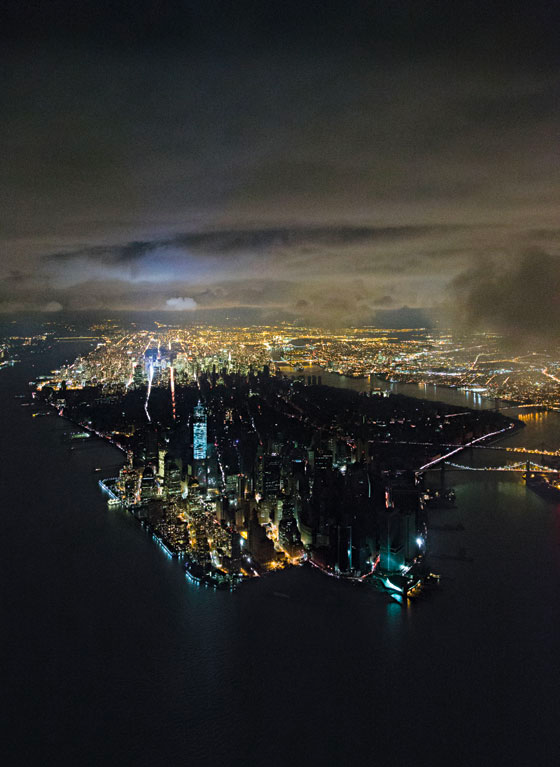Sandy + 10
by Sonam VelaniA powerless New York. By Iwan Baan / New York Magazine
Ten years ago this week, Hurricane Sandy swept through New York City. For many of us who lived here at the time, we can vividly remember the blackouts below 14th street in Manhattan, water up to our thighs in waterfront Brooklyn, and sheer debris and devastation in frontline communities like the Rockaways. Over 40 people passed away during the storm and there were over $19 billion of damages citywide.
A decade later, the city is still rebuilding – arguably with hindsight in place. New building codes that require mechanicals to be placed on the roof instead of in basements, waterfront parks to soak up storm surges and sea level rise, and a slew of investments in adaptation, resilience, and mitigation are helping to put New York on better footing.
But the efforts are inching away rather than progressing at warp speed. A new report by the City Comptroller shows that of the $15 billion in federal grants the city received in the aftermath of Hurricane Sandy, only 73% of the funds have been used thus far. New York is set to receive billions from the Infrastructure Investment and Jobs Act and the Inflation Reduction Act - how quickly can it deploy this funding in our streets and neighborhoods, protecting us from future storms AND reducing their frequency over time?
A rendering of the new East Side Coastal Resiliency Project that’s currently under construction in Lower Manhattan. Photo by AKRF
Dangerous storms will put $242 billion of property at risk of coastal flooding by the 2050s. The city’s public housing, 17% of which is in the 100-year floodplain, will be hit hardest. Additionally, significant essential infrastructure systems are in the floodplain – a whopping 79% of our transportation and utilities are on the waterfront (everything from the 14th St ConEd transformer that went dark in 2012 to the Newtown Creek Wastewater Treatment Plant to the Sanitation Department Transfer Station on East River)! Many of our coastal resiliency projects like the plan to protect the Big U of Lower Manhattan are still in progress.
All this is an important reminder to take stock. And do more. A lot more.
Parachute is a creative storytelling platform by Lyn Stoler and Sonam Velani (hello again!). We explore climate solutions in cities across the world - what works, what doesn’t, and why. Plus, it comes with some cool illustrations like this one!
First and foremost, VOTE! Ironically enough, early voting for the midterm elections starts on the day Sandy made landfall in NYC – October 29. You’ve got until November 6 to vote at any of your local sites, or get out there in person on Election Day itself, November 8. The ballot includes the proposed Clean Air, Clean Water and Green Jobs Bond Act, which would authorize $4.2 billion for environmental and resiliency efforts and a range of mechanisms to ensure the funding is deployed quickly and efficiently. Here’s a great primer from our friends at the Waterfront Alliance on why this legislation is so important to get across the finish line.
Second, rebuild for resilience. For every $1 invested in pre-disaster mitigation, we save $6 in post-disaster losses. The math is pretty simple, if you ask me. As we’re drawing up big plans, we must ensure that we’re leveraging a lot more green infrastructure - like mangrove forests or oyster farms (go visit our friends at the Billion Oyster Project on Governors Island!) rather than gray infrastructure like boring old levees and seawalls that cost a whole lot of money and have mixed results. Bonus points: the green shoreline defenses have co-benefits like urban cooling, carbon sequestration, ocean de-acidification, biodiversity promotion, job creation, and more.
Third, build some technology. An astounding 93% of our climate resources go into mitigation - basically, reducing the amount of greenhouse gasses in our atmosphere. Things are going to get a lot worse before they get a lot better, and we MUST invest, build, and deploy climate adaptation technologies. Some of my favorites: The Addition Company, building living sea walls to protect coastal communities; infraSGA’s RAFT bioretention system to move surface water into the ground and prevent flooding; and Zilper, which can install affordable and adaptable underground utilities in water resilient enclosures.
The Living Breakwaters Project in Staten Island developed by Scape Studio is an excellent example of climate adaptation design and technology at work! Photos by Scape Studio
But most of all, get you there into your streets and neighborhoods and see the creative solutions that are already underway. I recently got to hop on a boat with a hundred of my fellow climate adaptation enthusiasts and visit Staten Island with Open House New York and Scape Studio, one of the leading design firms leveraging living infrastructure to create beautiful public spaces right in our backyards. The Living Breakwaters project is a model for climate-adaptive green infrastructure, and includes 4,200 feet of partially submerged stone structures that break waves, reduce (and eventually reverse) erosion, and create a habitat for a variety of marine species. Beyond the physical breakwaters, the project aims to build social resilience in the Tottenville community on the South Shore of Staten Island that was devastated by Hurricane Sandy. Thirteen local schools are participating in educational programs and the next generation is learning about all the creative, climate oriented careers they can indulge in (hello future NY Climate Tech members!).
The climate crisis is moving faster than we are, and we’ve got to do something about it today, not all the way in 2050. Let’s go!
by Sonam Velani


